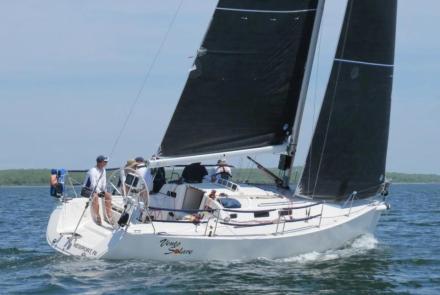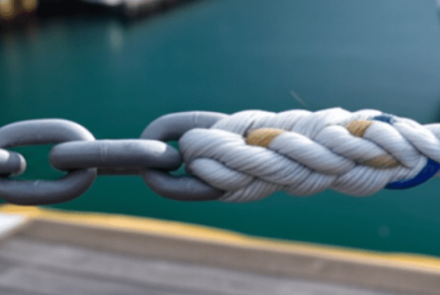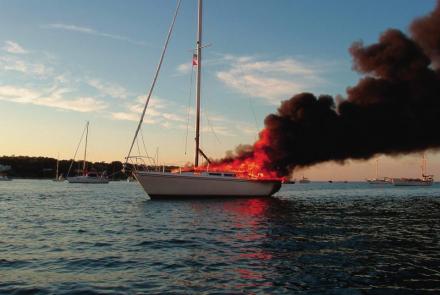Is That Rope-to-Chain Splice Really Good Seamanship?

“Safety Moments, presented at CCA Stations and Posts”
By Chuck Hawley, San Francisco
Five CCA members, including the author, chartered a 44’ sailboat during the recent Three Corner Cruise in the San Juan Islands in September of 2025. Our boat was equipped with a vertical axis windlass, with an anchor rode comprised of approximately 150 'of galvanized chain, and approximately 100’ of eight plait nylon line. As we anchored in relatively shallow waters during our cruise, we never needed to pay out enough rode such that the nylon line was in use. However, during a layover at Friday Harbor, we elected to run out the entire length of rode so that the anchor locker, which was a muddy disaster, could be cleaned out.
As we paid out the anchor and rode into the harbor, we eventually reached the rope-to-chain splice, which passed around the gypsy with only a modest amount of resistance. The splice appeared to be in good shape, with no visible signs of abrasion, perhaps because previous charterers had never had to pay out that much rode.
The rope-chain gypsy appeared in the yachting market In the 1980s, and was patented by Simpson Lawrence, maker of the CQR and Delta Anchors, as well as Simpson Lawrence windlasses. I had been working for West Marine for a couple of years, and was interested in whether nylon line, spliced directly to a link of chain, would hold up in real life. Rope (or line in the yachting world) doesn’t like to be bent around objects (cleats, sheaves, shackles) because the fibers on the outside of the item are pulled tighter than those on the inside due to the difference in circumference. This was a big problem in the early days of Kevlar fiber used in running rigging, which required large sheaves to attain its full breaking strength.

I asked New England Ropes to participate in a quick test to see what effect a rope-to-chain splice would have on the strength of new samples. I made up 15 test samples: 10 with ⅝” three-strand line, 5/16” BBB chain, and a 5/16” galvanized shackle, and 5 samples with ½” three-strand nylon line, ¼” proof coil chain, and a ¼” galvanized shackle. The claimed ultimate strengths of the components were as follows:
Test Sample Size | LIne | Chain | Shackle |
Large (5/16”, ⅝”) | 12,200# | 7,600# | 9,000# |
Small (½”, ¼”) | 7,500# | 5,000# | 6,000# |
Incidentally, the relationship between Working Load Limit (the maximum load you’re supposed to put on an item) and its ultimate strength varies dramatically by what item you’re considering. Galvanized shackles generally have a 6:1 ratio, that is, if you see the shackle stamped with WLL 1T, meaning one ton working load limit, it should actually withstand 6 tons of tension before failing.
Each sample was pulled to failure on New England Ropes’ line testing machine, and the tension at which the sample failed was recorded. Incidentally, New England Ropes quotes the spliced strength of a line in their specifications, so there was no need to use a reduced ultimate strength due to the presence of the splice.
In virtually all instances, the following was observed:
- The samples failed where the line was inserted and wrapped around the link of chain.
- The average breaking strength of the large samples was about 10,695#, thus exceeding the claimed strength of the chain and shackle, and achieving about 88% of the claimed strength of the rope alone.
- In all 10 large samples, the links of chain showed stretching and the anchor shackles had bent pins, indicating that they were close to failure.
- The average breaking strength of the small samples was about 5,937#, thus exceeding the breaking strength of the chain and very close to the breaking strength of the shackle, and achieving 79% of the strength of the line.
- Two different splices were used:
- Two strands inserted in one direction, and one strand inserted in the opposite direction of the link of chain (as recommended by some windlass manufacturers).
- Three strands inserted in one direction of the last link of chain.
- Of these methods, better results were obtained when all three strands were inserted in the same direction (85% vs 75%).
It goes without saying that this test used new materials that were pulled with a steadily increasing load, and not the cyclical loads that anchor rodes are subject to. There was no gravel or sand to abrade the nylon rode. The splices had not been run around a small radius gypsy repeatedly. However, it did show that on new samples, splicing the line around a link of chain still retains a high percentage of the strength of a line.
For more information, you can search for Rope to Chain Splice Test online, and find the article with many other technical articles on the US Sailing Safety at Sea pages online.
The Cruising Club of America is a group of accomplished recreational offshore sailors bound together by friendship and the desire to foster the responsibilities, expertise, and skills needed for the adventurous use of the sea. Safety Moments are brief updates on marine safety issues, presented by station Safety Officers at meetings. They are published by the CCA Safety and Seamanship Committee and are intended to advance seamanship and safety by highlighting new technologies, suggestions for safe operation and reports of maritime disasters around the world.





